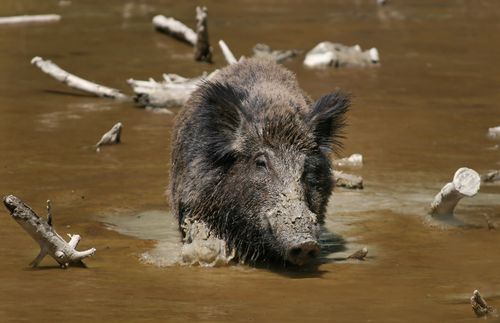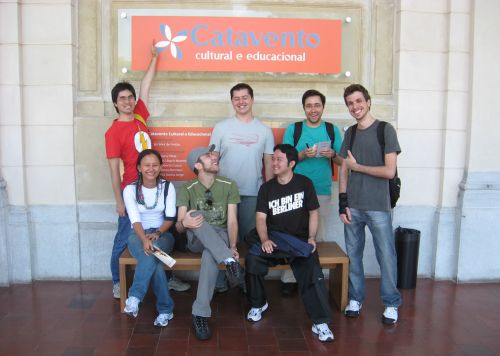Swine flu: guns, germs and steel

It is quite hard to think of anything other than the aporkalypse (get it?) these days (even more if you are working in real-time journalism… *sigh*). So, let’s put the hysteria to use in favor of a very important archaeological lesson: how the domestication of pigs and other animals transformed health in human societies? In many cases, to worse… Much worse.
Summarizing and simplifying things, it is almost certain that our species has to deal with rapidly spreading -and potentially deadly- infectious diseases only because it learned to breed other animals in large numbers. Flu (of course!), smallpox, whooping cough, measles, cholera, diphtheria, typhus, TB – imagine how many people died from something on that list before the development of antibiotics and modern medicine.
It just so happens that all those diseases started their “career” as zoonoses, judging by their pathogens genetic likeness with viruses or microorganisms carried by domestic animals. This hypothesis is one of the main elements of the – already classic – book “Guns, Germs and Steel”, by the american biogeographer Jared Diamond, from UCLA (hence the title of this post). You just have to look at the process the transformed wild boars (like the cute fella from the photo above) into little domestic piglets to realize that the epidemiological dynamic turned inside-out because of the domestication.
Densities, densities
First, one can hardly compare human and animal populations densities before and after domestication events. It’s true that big wild mammals such as horses, boars, sheep and cattle lived in big herds before turning into farm creatures, but rarely so many of them were confined in small space like they are now, thanks to us.
And, of course, a positive feedback happened between human and animal populations; the amount of animal protein (meats and milk), fuel (feces), fertilizer (feces once more), source material (bones) and clothes (hide) available to breeders of large mammals is exponentially superior to the amount that could be gotten by even the best hunters/gatherers. Include agriculture and you have, of course, the possibility of sustain lots more people in the same land space. Luckily, this excess people, also thanks to the animals, gets more mobile, being able to move and colonize more land on oxen, buffalo, donkeys and horseback.
Think, for a moment, how unnatural (from the point of view of 6 million years of human evolution) the situation of the last ten millennia is: the chance the hunters/gatherers had of close contact with large mammals or even flocks of birds was negligible. Oog would thank the gods if he killed one bison a month. But now you have a lot of people and a lot of animals jammed in the same settlement; people messing with manure, meat, blood, lard and who-knows-what-else from cows, pigs and goats. (The “who-knows-what-else” is not just for dramatic effect. In Papua-New Guinea, women of certain tribes breastfeed pigs. Yep, breastfeed pigs.)
This unprecedented scenario not only made disease transmission easier between humans and animals, but also helped epidemic infectious diseases to become self-sustainable for first time in our history. If you are a hunter/gatherer who is unpleasantly infected by a killer pathogen from, say, monkeys, you can rest assure in the knowledge that your whole tribe of 50 will either died completely or be totally immune, very quickly. And the disease will very likely stay there, since those 50 poor bastards rarely contact other groups.
The whole thing goes haywire when we have dense populations of breeders e growers interconnected by commercial routes and constant extra-tribal interaction. Now even killer pathogens can benefit from the population critical mass to spread from one or more entire continents and do lots and lots of damage. Something very unlikely to happen in pre-domestication times.
Winners and losers
Diamond extracts an interesting conclusion from this whole line of reason: when invading Europeans set foot in America, Polynesia and Australia for the first time, who died from smallpox, flu, measles and other Euro-asian ailments were the natives. There is not one case of a native disease killing an European settler.
None of these people domesticated animals in large scales, with the exception of Incan llamas (which are the only American big mammal [1] domesticated).
Diamond notes that, together with lower population density, lack of domestic animals is the key. The Europeans were the descendants of those who acquired immunity and survived a vast quantity of microorganisms transferred by animals that wiped out truckloads of people in Eurasia. The natives were not.
One cannot deny the conclusion taken from this is quite gloomy. Modern hygiene measures and continuous follow-up can help, but if History serves as guide, the intensive breeding of animals and intensive human contact with them will produce many more epidemic scares in the future.
[1] It has been noted – in a comment – that Andes people also domesticated guinea pigs. Besides, almost all American tribes had dogs, like many Polynesians. Nothing, however, comparable, in scale or variety, to mammals domesticated in Eurasia.
——
This is a translated version of this post, written originally in Portuguese by Reinaldo José Lopes at Chapéu, Chicote e Carbono-14 and translated by Igor Santos.
The ghost of Samuel Cartwright

Samuel A. Cartwright was a very creative physician who worked in Lousiana, south of the United States, in the mid-nineteen century and contributed with both Cholera and Yellow Fever treatments. Often called by landowners to examine sick slaves, he coined some medical terms that, as many others in medicine, ran into oblivion. Who would know, today, what could be drapetomania? And dysaethesia aethiopica?
He learnt in important medicine schools and worked with other famous physicians. But, albeit his humanistic formation, he was a slavery supporter. It’s important to notice, however, that slavery was no crime back then. Having a position for slavery was more about defending a production method than a humanist cause, unbelievable as it may seem today. Draptomania (from the greek drapetes, slave) was a word created to name a strange psychiatric disorder that afflicted slaves at the time: an unresistable and unexplainable drive to flee from their masters! Dysaethesia aethiopica (from dysaesthesia = alteration of sensitivity, and aethiop = negroid), a syndrome “described” in 1851, was also a mental disorder, proposed to explain the laziness and lack of will to work, very common among slaves and with clearly contagious characteristics! Found exclusively in blacks, was a type of skin insensitivity that compromised the mental faculties. Given its “physiopathology”, it was “cured” with ointments on the skin, followed by whipping as to stimulate cutaneous sensitivity. Pretty much the same treatment was applied to drapetomania. Apparentely with certain success.
There are at least two sides to this story: first, realise there is some blame on the doctor’s part. A certain mix of malevolence with incomprehension, still seen frequently nowadays, that would justify its actions to himself and to his peers. Here we are facing another human imprudence and the discussion ends. There is, however, a much more cruel and perverse way of understanding the story. What if we abstract our current world view and transport ourselves to the south of North America in the XIX century? Whilst trying to understand the world and Cartwright’s evidences, we could think he, in fact, didn’t do any of this for any particular hate or despise to black people. We could understand that he did so just by following the current logical and scientific presets, characteristical of the style of thinking of his time and place. Today his findings belong to the worst pseudoscience and “scientific” racism. But, back then, his diagnoses were discussed in clinical meetings!
The ghost os Samuel Cartweight should haunt doctors and medicine today. It would be useful remembering doctors that the medical practice remains and will remain, notwithstanding the evolution of scientific knowledge. That we of now may be regarded as ridiculous for someone in the future trying to understand our doubts. That we are not different of the society in which we work, and that this provokes immense black holes when we need to think about our own acts. That science is a partner and not master of our actions. I would indeed like question this ghost. I would ask the ghost of Samuel Cartwright — which is transcendent in time and space, how burlesque and pathetic are my current good intentions? Which of my attitudes will pass to history as examples of grotesque and irrational?
I sincerely hope that the ghost of Samuel Cartwright will not appear suddenly, in an afternoon, after several and extenuating consultations, in the mirror of my office.
—
This is a translated version of this post, written originally in Portuguese by Karl at Ecce Medicus. Translated by João Carlos and Igor Santos.
How Brazil is dealing with the Swine Flu
In general, South America has not confirmed a significant amount of people with swine flu, which raises some eyebrows as it is one of the main regions that send and receive people from Mexico. Right now Brazil has 8 confirmed swine flu cases, 37 suspect cases and, curiosly, 188 cases that were dismissed as swine flu.
Of the 8 confirmed patients, 2 where infected in Brazil, from a 21-year-old that went to Cancún in his vacation and infected one of his friend and mother when he arrived. After he arrived from Mexico, he started feeling feverish, which he thought was a consequence of sun dehydration. The next day, he went to a private doctor, which concluded he had not swine flu. As the symptons persisted for another day, he decided to go to a hospital to be isolated. The young man has been released from hospital yesterday after being isolated for 10 days.
What is worrying about this story is that the patient went to a dance club after he arrived from Mexico. At the moment, Brazilian hospitals are screening for people with flu-like symptoms that have been abroad in the last 10 days. What about people that went to the same dance club as this patient?
Another worrying aspect of Brazil´s screening system is that Brazil has a significant number of flights that comes from Mexico every day, the number of people coming from Mexico has been estimated to be twice the number of people that go to UK from Mexico. However, UK has reported 71 swine flu cases and we reported 8. Are we missing people infected with swine flu in Brazil? Is there another reason for those contrasting numbers?
Flu surveillance is very deficient in Brazil as we do not know what flu virus varieties are found in the population and their infection dynamics. Add that to the incoming flu season in hemisphere and we have a lot of reasons to worry. It is possible that we will only realise the size of the problem when it is too late.
However, what scares me most is how uninformed some of our key politicians are, like São Paulo state governor, former Brazil´s Health Ministrer, that said, when the first swine flu reports arrived: “Swine flu is transmitted from little pigs to people only when they sneeze or when the person get too close to the pig´s nose.”
Brazillions and Brazillions

Welcome to the Brazillion Thoughts, the blog that contains the best texts in ScienceBlogs Brazil translated to English.
One of the reasons we have decided to become ScienceBlogs Brazil was the opportunity to bring the perspective of Brazillian scientific bloggers to the rest of the world. However we could not just start blogging in English, as our main mission is to communicate Science to Portuguese-speaking communities and automatic translators, such as the one from Google, are still not good enough to correctly translate all the subtleties and humor of our texts. Portuguese grammar seems to be particularly hard to be understood by a bot.
The solution was to make a blog in our site exclusively in English that will have translated posts from our blogs. We intent to write here the best posts from ScienceBlogs Brazil and use this blog as an useful channel to spread the qualities and problems of the Science developed here.
We hope our thoughts will be interesting to the English-speaking blogging community. We also hope our voices will be read by people from different cultural background and the discussions will be useful to show what is to be a Science enthusiast in a country like Brazil.







